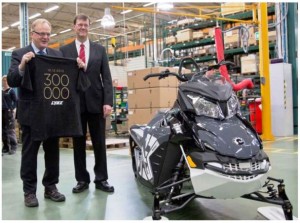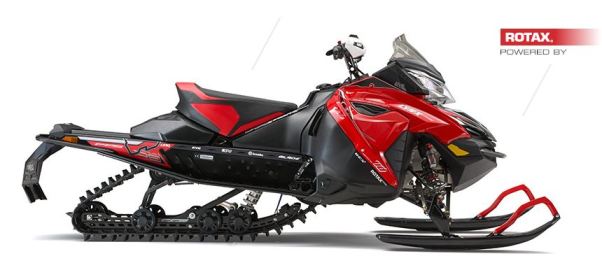There’s been a lot of talk over the last 30 years about who the “fifth” big snowmobile manufacturer might be. FAST Blade? Redline? AD Boivin? Scorpion? Redline? Trail Roamer? Honda? Crazy Mountain Xtreme? Yes, there have been several brands that have taken a swing at varying levels since John Deere and Kawasaki exited the market. But in terms of being a major fifth brand, we’re still waiting.

Or are we?
Bombardier Recreational Products (BRP) announced yesterday that the 300,000th Lynx snowmobile was built on December 16 in Rovaniemi, Finland. The model, a 2014 Lynx Boondocker 3900 with an 800 E-TEC under the hood, was celebrated much like when the 1, 2 and 3 millionth Ski-Doos were build in Valcourt, Quebec.
“I am proud of the work that has made BRP’s Lynx brand the leading snowmobile brand in Europe,” said Jukka Jokinen, the VP of BRP Finland. “The Lynx story began in 1967. With consistent research and development, we have since become industry leaders. Thanks to our employees who have made this milestone possible.”
Lynx Snowmobiles In North America?
If they’ve been asked once, they’ve been asked 1,000 times: Hey Ski-Doo, why not bring Lynx snowmobiles to North America?
Over the years, there have been varying levels of crossover between Ski-Doo snowmobiles and their step-sister machines made in Finland. The crossover gets very tight in some areas, but there are great variations in others.
Looking at the 2014 lineups, the engine platforms are identical: Lynx machines are available with 600- and 800-class E-TEC two-strokes, 600- and 900-class ACE four strokes, a 1200-class four stroke and a 550-class fan-cooled, carbureted two-stroke. Sound familiar Ski-Doo fans? Also, the short-tracked performance models all come in a new generation of the REX chassis, called REX2, which has some of the same platform changes as the REV-XS package — though the body panels have some notably different shapes.
However, you’re not going to find a plush rMotion skid in the back of a RAVE snowmobile, Lynx’ equivilent of an MX Z. Instead, it’s the uncoupled PPS suspension. In the past, Ski-Doo officials have been quick to point out that Scandinavian riders don’t get the groomed trails that have so spoiled us in North America, so their suspensions are sometimes more aimed at big (as in, really big) bump performance.

Looking at the RAVE, it has a different seat, exposed frame rails, more geometrically shaped body panels and it appears to have more of a snub nose, not unlike Polaris race sled. Traditionally, Lynx machines have often had more inboard-mounted shocks than Ski-Doos on the front suspension, but that difference appears to be disappearing as the years pass. The gauges appear to be the same units, but the skis definitely are not. Wider skis aimed at better floatation are used on the Lynx, again due to the conditions most riders in Scandinavia regularly ride in.
The Lynx lineup includes varying levels of partial or totally off-trail machines (think Renegade vs. Freeride vs. Summit), a handful of touring machines and a deep lineup of utility sleds, just like Ski-Doo. But again, they appear a bit more rugged-looking when built for European use. The BoonDocker SD 3900 is the Summit equivilent. It has the FlexEdge track like a Summit, but we’re not seeing anything to indicate that there’s any tilt build into the rear suspension, like the tMotion.
Now, to the central question: Will Lynx snowmobile find their way to North America anytime soon? Our guess would be “No.” It would take a fairly large investment for BRP to establish the brand in the U.S. and Canada — from setting up a dealer network to creating a sales force to signing racers to advertising and marketing and beyond. And, considering Ski-Doo’s already dominant position in the marketshare battle on this side of the Atlantic, we’re not sure the BRP corporation would gain much share. The easiest converts to Lynx, frankly, would be current Ski-Doo loyalists, who already have an appreciation for Rotax engines, REV-style chassis and other BRP features.
So, financial reality gives a negative answer. Taking logic out of it, though, we think it would be fun to see a Lynx on the trails this winter.


This is interesting isn’t “LYNX” an Arctic cat trade mark
No.
I agree with you Todd. Arctic Cat has it first and the name Lynx should really belong to Arctic Cat. BRP would not dare to bring Lynx sleds here or the Cats going to maul the Doos in court. You notice it appears that Between Cat and Doo there is a bitter fight on names and appearances? Lynx is not only one! The Z name belongs to the Cats, not Ski-Doo (as in MX-Z) I calls them MX, period, not MX-Z! The Lynx–I call them Moto-Ski (the BRP brand, not the Cat model Lynx)
Also you should notice a 2014 Ski-Doo has a sled with Arctic Green on it? Yup! Why not Cat buy out BRP?? They should! That’ is why I do not buy SD. I buy Cats or Polaris.
I know this is quite a bit late, 8 years late, but you do realize that Lynx Brand was founded in 1967. Whereas the earliest Arctic Cat Lynx Model that I could find was released in 1971. So Bombardier Recreational Products could effectively sue over that. Plus names, colors, and letters, all of those things have free licensing anyway as long as long as they aren’t obvious copies, which is why the whole argument about names using the same letter is totally bogus. MXZ and ZR are 2 totally different names now if Arctic Cat started calling their ZR an MXZ or vise versa there would be a problem, same idea goes for colors.
Plus I think you now know why they didn’t buy out BRP, the largest snowmobile manufacturer on the planet, they went bankrupt and are now owned by Textron, you know now that Lynx is in North America. So Double Future win for BRP.